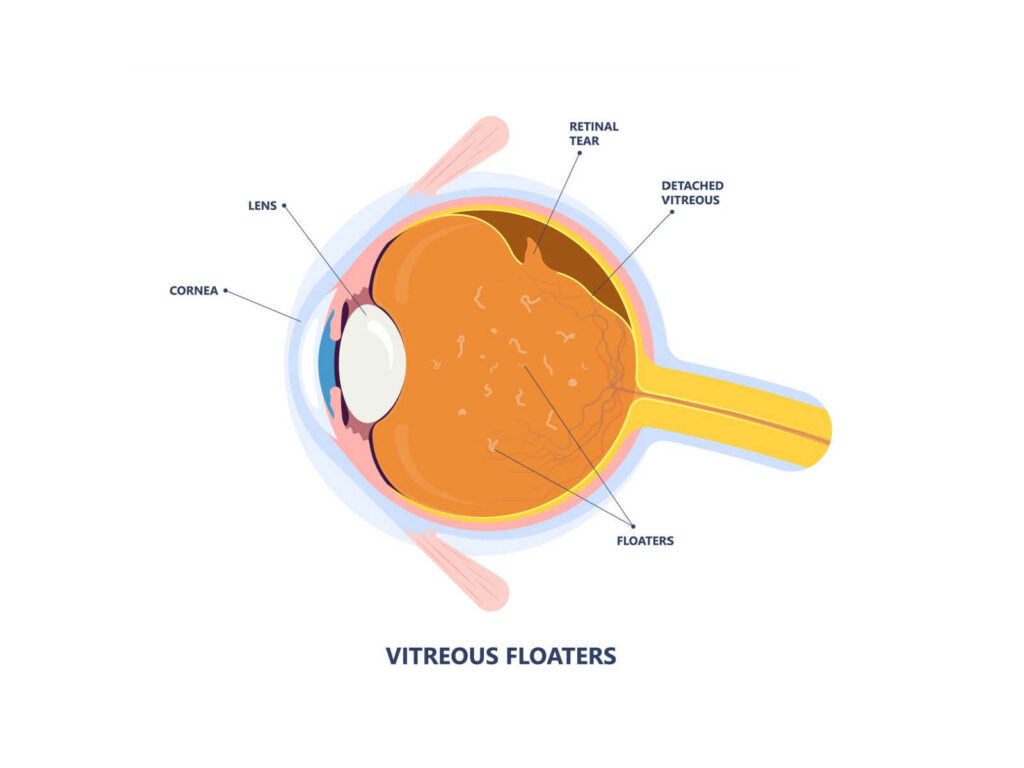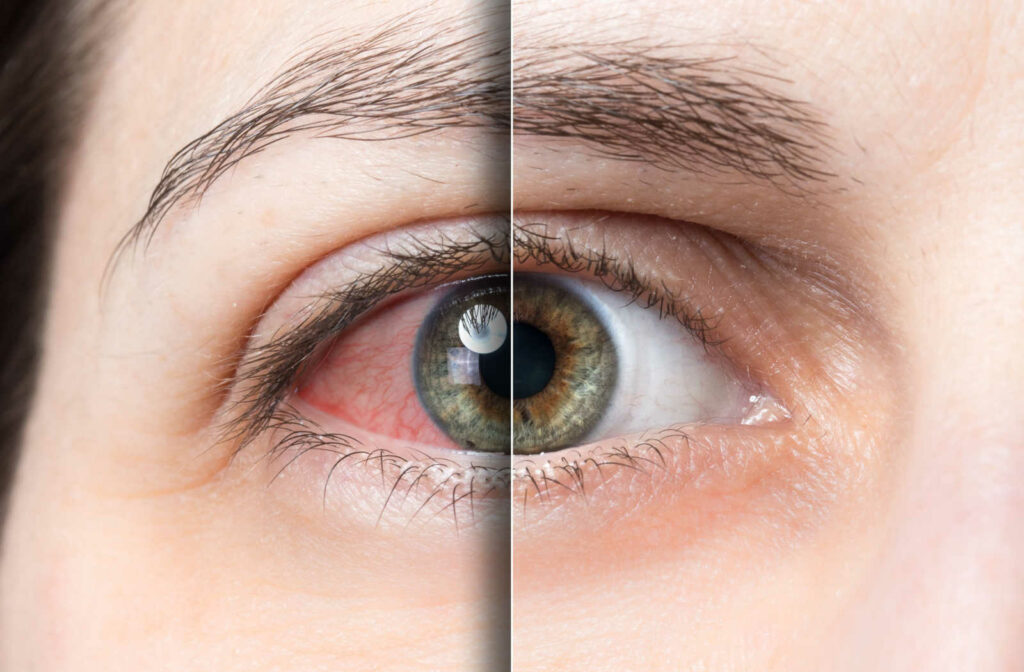Most of us will likely experience dry eyes at some point. And many things can contribute to dry eyes, whether dry winter air or poor-quality office air. But for around 30% of Canadians, dry eye syndrome is a constant battle.
At a quick glance, other than the discomfort of having dry, itchy eyes, most people don’t think too much about any complications related to untreated dry eye. Also, there are times when an underlying cause is the root of your dry eye problems. So, a comprehensive eye exam by an eye doctor is a good idea.
Can Dry Eyes Cause Vitreous Detachment?
There are several complications related to untreated dry eye disease, which we’ll look at below. Some may think that vitreous detachment, or the little dark floaters in your vision, are caused by dry eye because the conditions share some common risk factors. However, there isn’t any evidence that points to dry eyes causing vitreous detachment.
Risk factors that the two conditions share include:
- Age
- Diabetes
- Cataract surgery
- Eye trauma or damage
- Infections
What Is Vitreous Detachment?
Vitreous is a gel-like fluid in the middle of the eye. Sometimes, strands of this fluid clump together in the eye; this commonly happens with age. When the fluid clumps and forms larger strands, it casts shadows over the retina. In turn, this causes us to see what many call floaters in our line of vision.
Treating Vitreous Detachment
In most cases, there is no necessary treatment for vitreous detachment. Most people find that it does not affect the vision enough to warrant correction. However, if the floaters begin causing vision issues, there is a procedure called a vitrectomy that can remove them.
That being said, if the vitreous detachment is severe enough, it may cause other problems that may need treatment. Some of the complications include:
- Retinal tear
- Macular hole
- Retinal detachment
- Macular pucker
Dry Eyes
Just because we don’t have to worry about dry eyes causing vitreous detachment doesn’t make them any less uncomfortable. And unfortunately, if an individual is dealing with chronic dry eye symptoms, it’s unlikely they will go away on their own.
Symptoms of Dry Eye
There are a lot of things, ranging from air quality to various medications, that can cause dry eyes. However, the symptoms are typically fairly universal. One thing to remember is that some of the symptoms of dry eye disease are shared with more serious issues. So, if over-the-counter (OTC) lubricating eye drops don’t solve the problem, it’s a good idea to see your eye doctor.
Some of the symptoms include:
- Light sensitivity
- Red eyes
- Itchy eyes
- Stringy mucus discharge
- Watery eyes (even though it seems contradictory)
- Stingy, burning, and itching eyes
- Blurry vision
- Hard time with nighttime driving
- Difficult time with contact lenses

Treating Dry Eye
In most cases, symptom management is the treatment for dry eyes. This is typically as simple as OTC lubricating eye drops because the two major causes are inadequate tear production or excessive tear evaporation. However, suppose something is causing the symptoms that aren’t improving with eye drops. In that case, the eye doctor may suggest other treatment options.
Some of these potential treatments include:
- Changing medications
- Anti-inflammatory medication for eyelids or corneas
- Medication that encourages natural tear production
- Special inserts that act like artificial tears over time
- Special contacts, such as scleral lenses
- Eyelid massage coupled with a warm compress
- Meibom gland expression or stimulation
Potential Complications From Untreated Dry Eye
Other than the obvious discomforts involved, it’s important to consider the potential complications that can arise if dry eye syndrome is left untreated. A common complication is an overall decline in your quality of life. Painful, dry eyes can make it a struggle to simply accomplish normal daily activities.
When dry, your eyes are more prone to infection as well because the tears help form a protective layer that makes it harder for germs to infect the eye. Additionally, people with dry eyes will typically touch them by rubbing or itching them more often. This can contribute to an increased risk of infection.
Finally, without the lubrication of tears, the eye’s surface can become inflamed. This can lead to moderate or severe damage, such as corneal ulcers, abrasion of the corneal surface, or vision loss in extreme cases.
Learn More About Your Treatment Options
Even though it’s common, dry eye disease remains a treatable condition. Unfortunately, the treatment is typically ongoing, depending on the severity. Prevention of dry eyes is the best treatment. But if you can’t get a handle on the symptoms with OTC and home treatments, then a visit to the eye doctor is a good idea.
Give us a shout at eyeDOCS today. Our knowledgeable staff can answer your questions and book you in at a convenient time to see one of our optometrists about your dry eyes.




